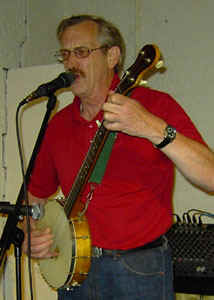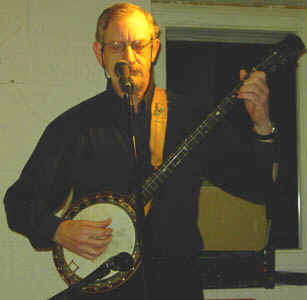[Das Navigationsleistenfeature ist in diesem Web nicht verfügbar.]
 So why am I suddenly "John E.
Dallas", with a middle initial?
So why am I suddenly "John E.
Dallas", with a middle initial?
The answer is, "Because this is my banjo page!" And it so happens that there was a prominent maker of banjos named John E. Dallas in London in the early 20th century! The banjo depicted on the left is one of his. He manufactured other instruments and published music, too, but the banjo was his first product.
Click here to see the banjos I use!
So it seems I was in some way predestined to become a banjoist. Certainly my parents did not give me my first name and middle initial just so that I would sound like a banjo manufacturer, with whom we have no family connections. It just happens that one of my grandfathers was called John, the other Edward.
My banjo playing evolved in stages:
The second portentous event, which occurred when I
was about 10 years old, was my father's return from a business trip to the Outer
Hebrides with an oddly-shaped case containing a somewhat decrepit fretted
stringed instrument, which he had had given to him on the assumption that he
could find out what it was on the "mainland" (we were living in the
Western Highlands of Scotland at that time). If it could be made usable, he
could keep it.
So he found out that it was a 5-string banjo, and on his next trip to the Big
City (Glasgow) he bought strings and a bridge. The tailpiece was also missing
(as we discovered when trying to string it up) so Dad made one out of an old
toilet-seat hinge. One of the pegs was missing, too, but Dad whittled one out of
wood, on the pattern of a violin peg.
So I had a playable 5-string banjo at an early age!
At that age, however, my fingers were still too short for the wide frets of a banjo, so I continued to play the mandolin and fiddle for some years. By the time I had grown to full size, the 1960s had arrived, and with them the "Great Folk Scare," as it is sometimes called. Folk was cool, especially in Ireland, whither my family had meanwhile returned. I immersed myself in the music of the Clancy Brothers and Tommy Makem, then in that of The Dubliners. But I had no guitar! What could I sing to?
Well, Tommy Makem and Luke Kelly of The Dubliners both played 5-sting banjos. Why shouldn't I? My destiny began to fulfil itself!
All the song books had guitar chords in them; the slim banjo tutor that my father had bought along with the bridge and strings had chord diagrams in it; there was really no stopping Fate...
But first, I had to get rid of that improvised peg and tailpiece. I was at school in the Big City (Belfast) now, and there was a music shop just opposite the school gates. So I obtained a complete set of new pegs and a proper tail-piece. My banjo was now not only playable but also presentable, and so I banjoed and sang my way through University.
When I moved to Germany in the early 1970s, my banjo came with me, and I used it as a teaching aid in my English classes at an Essen boys' grammar school. But its head split in the unaccustomed, centrally-heated environment of my German flat. Not too long after that, I met an American banjo-repairman in Stuttgart, who sold me a skin head and instructions for fitting it.
This is a recent photo of me playing this banjo at an open
mic venue in Böblingen, Germany: 
My banjo was better than ever...
...except for an annoying "off-tune-ness" that no amount of tuning could eradicate. By trial and error and a bit of gut feeling, I discovered that a "fret zero" about a millimetre from the nut was all that was needed to fix this, and inserted one. While I was about it, I lowered the action, and the banjo is now one of the most perfectly in-tune, playable instruments that I possess! The latest modification, at the end of 2004, was the fitting of nylon strings, so now that old derelict has metamorphosed to a classic banjo! For loud, 3-chord accompaniments, I use the aluminium-pot resonator banjo that I bought soon after forming the group interFolk.
OK, so I started playing accompaniments on the banjo at about 18. How?
Well, just following that primitive tutor and the chords in the song-books, really. The tutor said to play the 1st string with the middle finger, the 2nd string with the index finger, and the other three with the thumb. So I did that. "Thumb-fingers, thumb-fingers" for 4/4 time, "thumb-fingers-fingers, thumb-fingers-fingers" for 3/4 time. After a while, my fingers started separating and I could pick "thumb-index-middle, thumb-index-middle" patterns, which as I later learned are called rolls.
So quite by accident (Fate?) I developed a style of accompaniment that is neither bluegrass nor frailing, the two main styles played in the banjo's homeland, the USA. More like the style of the Irish ballad singers of the '60s and '70s, whom I did not, however, copy directly. I just learned the banjo the way they did - by trying to exploit the instrument's capabilities without an American folk musician to teach me!
So, for decades, I played accompaniment-banjo, first for solo gigs and from 1991 on with my group, interFolk. Then, at an interFolk gig in 2004, someone requested a number that would showcase my banjo.
Oops! All I had to offer was a song with a rather neat but totally unspectacular banjo accompaniment - not quite what they were looking for...
...So since then, I have been working hard on the classic or finger-style banjo. Listening to historical recordings of players like Ollie Oakley, and corresponding with banjo-players in the Internet prompted me to restring that old banjo with nylon strings, as classic banjoists do (in the heyday of classic banjo, the strings were gut, of course), and then I obtained an old English zither-banjo, a once popular instrument with professional finger-style players.
The zither-banjo is a 5-string, tuned like the standard classic banjo (gCGBD)
but with wire 1st, 2nd and 5th strings and gut or nylon 3rd and 4th. This
produces a remarkably good balance. I have now taken to using the
zither-banjo for accompaniment, too: it is louder than the gut-strung open-back,
but better balanced in tone than the modern resonator banjo. Here I am at the open mic in Böblingen again, this
time with the zither-banjo:
the modern resonator banjo. Here I am at the open mic in Böblingen again, this
time with the zither-banjo:
(To be continued.)